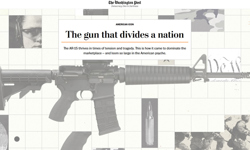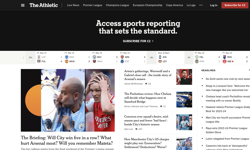When I called the New Milton Advertiser’s newsroom to ask to speak to someone about the paper’s endurance, the reply from news editor Andy Sherwood was a gem.
“Goodness, it better not be me, I’ve only been working here 30 years! You want to chat with Charles; he started 75 years ago…”
Charles Curry MBE joined as a 16-year-old office junior back in 1936, becoming editor after his father in 1966. Now in his 92nd year, he must be Britain’s, if not the world’s, oldest and longest-serving editor, so it’s understandable that his newspaper looks like it’s been pulled out of a 1960s archive.
The broadsheet size is huge, measuring 63.5 x 44.5cms, the front page alone carrying eleven news stories, two pictures, five adverts, a content panel and as detailed a masthead as you will ever see – all in black and white.
Despite archaic looks, the New Milton Advertiser is packed full of real street corner content – termed ‘hyperlocal’ in the modern world. Crime, courts, planning applications, schools, council reports and letters, and all from the two towns and surrounding villages it serves. Nothing more regional than Christchurch, just five miles away, and nothing national, let alone international.
While the vast majority of hyperlocal websites scarcely raise enough revenue to cover hosting costs, the New Milton Advertiser and its sister Lymington Times edition are full of adverts, and together sell nearly 20,000 copies a week in their coastal corner of Hampshire, just below the New Forest.
Charles was far too cute to reveal exact profit figures, but he was proud of how many local people the company, founded in 1928, still employs in 2012.
“We’re the largest small newspaper in the country. We employ 50 staff – 25 full-time and another 25-odd part-time, many pensioners like me! We still make profits after paying all those wages, buying all that paper and paying the rent.”
And he cackles with delight when explaining why his newspapers are still successful: “We simply produce a product that people can afford. If you can do that, you’re in business, if not you’re not.”
The cover price of the New Milton Advertiser and Lymington Times is 35p for a regular 28 broadsheet pages, whereas the Southern Daily Echo in nearby Southampton costs 45p for what’s often only 40 tabloid pages.
The papers’ advertising rates are also competitive, from £4 for an 18-word announcement to £1,276 for a full page – both prices including VAT.
“We deliberately under price the newspaper so that readers can afford it”, said Charles, “and to annoy competitors! Advertising is the same. We have nobody knocking on doors soliciting – they come to us because they know everyone in this area reads us, and we’re affordable.
“But you should never take advantage of a monopoly because you can only do that once and they won’t come back. They say successful businesses should ‘charge what the market can stand’. We charge less than the market can stand, and that’s helped. Yes, we could have made more money, but then we might not still be here.
“Most papers are not owned by journalists, they’re run by businessmen with shareholders to please and rising profits strategies that always lead to downward spirals.
“They constantly put prices up too high leading to fewer advertisers and falls in revenue, provoking another round of editorial redundancies, then less quality, fewer sales and another drop in advertising.”
Charles is also passionate about his editorial strategy: “For local issues, we’re the only media available with every cough and spit, whereas others try to ape the nationals.
“If a boy falls off his bike and breaks his leg in Lymington, that’s a good story for us. If 12 are murdered in Southampton, [18-miles away] it’s not.
“And as a newspaper, you don’t bend. I’ve always put editorial ahead of advertising, asking questions others don’t ask, upsetting a few councils. I don’t belong to any other organisation – you can’t have two loyalties.”
So what about the future? The New Milton Advertiser and Lymington Times have an interesting website at www.advertiserandtimes.co.uk with maps, information and contact details, but it carries no news or adverts other than an image of that week’s front page. How long can this strategy succeed?
“You tell me,” said Charles, the titles’ sole proprietor. “And when’s Earth going to hit Mars?”
“I’m sure the internet might take over in the end because they’ve no overheads, but they haven’t yet, and we’re working on a succession plan for when I’m no longer around.”
Southwark News
It was a much younger voice that greeted me when I called the Southwark News, London’s only paid-for, independent weekly newspaper.
It was launched as an A4 news sheet back in 1987 by the late Dave Clark, an experienced and respected former national journalist, quickly developing into a viable business.
After Dave’s untimely death in 1998, the newspaper passed through a variety of hands before young reporters Chris Mullany and Kevin Quinn took over in 2002 – aided with print and finance experience from minority shareholder David Ellis.
Ten years later, Chris is still only 37 (Kevin’s 35), but the Southwark News now employs 20 staff, has a growing weekly circulation of 12,208 and a readership of more than 30,000.
“When people discover the paper, they like it and often carry on reading it”, said Chris. “It’s held pretty steady and we’d like to get to around 14,000.
“When the recession first hit, we cut staff down to around 10, which was painful, and hard on good people we had to let go. But we’ve expanded again, and over the past year, have gone from around 15 up to 20 full-timers.
“We now have five journalists and have brought in a deputy editor, building up editorial rather than just advertising staff, as so often seems to be the case with papers.
“It takes a great deal of work, but we’ve made a steady profit for the past three years, and hopefully this will continue.”
Expansion during recession sounds rare, a feat Chris puts down to sharp business acumen and great content.
“Speaking frankly, advertising keeps the doors open – you can have the best newspaper in the world, but if you can’t afford to print it and pay wages, it’s game over.
“Yet you wouldn’t get any local advertisers if people didn’t pick the paper up and buy it. As both of us are journalists by trade, we recognise it’s the quality of stories that keeps a paper alive.
“Despite the debate about the death of newspapers, we still believe there’s an appetite for good quality local journalism.
“It’s about constantly trying to improve your product, offering sensible and reasonable advertising rates and packages that won’t break the bank, but may help local businesses get more people through their doors.”
Chris is effusive about the efforts made by his and Kevin’s small but growing team: “We all work long hours, and everyone rolls their sleeves up and pitches in, so we all take satisfaction from the papers we produce.
“There’s nothing better than seeing a campaign that’s been worked on for a long period come to fruition, or seeing an advertising feature that’s been well pitched and nicely designed hit the streets.”
Interestingly, the Southwark News gives nothing away for free on its website at www.southwarknews.co.uk.
“It’s an anomaly that web content for papers has, by and large, been free to access. We made the decision a couple of years ago to charge the cover price of the paper – 40p – for our online version.
“We pay our journalists to produce high quality journalism – I can’t see how we can carry on doing that if people can read it free online. We explained this to website readers and I think people accept it’s about preserving good journalism, rather than trying to make a fast buck.”
Chris and Kevin are determined to get through the recession, despite recent suggestions that the government might end local authorities’ obligation to place Traffic Notices in local papers.
“Nothing’s certain in business”, said Chris. “For example, ending traffic notices would have a significant financial impact. But if we can grow during a recession, then hopefully we can thrive at the end of it.
“Again, it’s about adapting, being imaginative and creative in what we offer and produce, and being daring.”
filtonvoice
The new kid on the independent newspaper block is Richard Coulter, a former assistant editor of the Bristol Evening Post.
He took redundancy last year and is now a one-man business producing filtonvoice, a monthly hyperlocal newspaper for the Filton suburb of northern Bristol.
Delivered free to 5,000 local homes, filtonvoice is in quarterfold format (slightly smaller than A4), and has a 50:50 editorial to advertising ratio across 32 to 48 pages. The average edition carries 50-odd adverts from local businesses, priced between £25 and £250, and after costs makes a profit that’s already in four-figures and is growing each month.
Richard decided on print after watching and scratching his head while other journalists poured great efforts into hyperlocal websites, attracting tiny revenues that made them unpaid hobbies.
“Digital journalists assume everyone’s like them. This has been one of the biggest mistakes: because one new toy comes long, all old ones must be thrown out.
“Some people may not like paying for print publications and they may find them more difficult to obtain, but that doesn’t mean the medium itself is flawed.
“Local communities have had a sense of being disengaged over many years now. Yet they crave information and want it in a format which is delivered to them.”
There is a website at www.filtonvoice.co.uk, but it’s limited to breaking stories and content already published, as Richard sees no worth in devaluing his newspaper.
“It’s a print model offering advertisers certain numbers through certain letterboxes in a niche market. I’m not sure digital can yet offer such good assurances. I’ve had just one advertiser request the website.”
Importantly for Richard, filtonvoice quenches his journalistic thirst: “It’s the grass roots level of grass roots journalism – discussions on potholes, traffic calming and street lights. I will not win a Pulitzer Prize, but it’s relevant and interesting for local people.”
Richard said the key is for trained journalists to produce quality content for their local patch and to sell advertising – either developing sales skills or partnering with former sales reps. He himself pays commission to Emma Cooper, a former advertising manager from his Evening Post days.
He’s now planning training seminars for other redundant journalists – offering them a way back into the profession as mini entrepreneurs in their own neighbourhoods.










